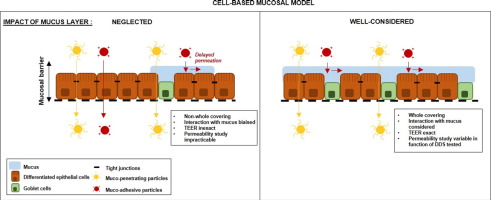Advanced Drug Delivery Reviews ( IF 16.1 ) Pub Date : 2017-07-25 , DOI: 10.1016/j.addr.2017.07.019 Anna Lechanteur , José das Neves , Bruno Sarmento

|
The increasing interest in developing tools to predict drug absorption through mucosal surfaces is fostering the establishment of epithelial cell-based models. Cell-based in vitro techniques for drug permeability assessment are less laborious, cheaper and address the concerns of using laboratory animals. Simultaneously, in vitro barrier models that thoroughly simulate human epithelia or mucosae may provide useful data to speed up the entrance of new drugs and new drug products into the clinics. Nevertheless, standard cell-based in vitro models that intend to reproduce epithelial surfaces often discard the role of mucus in influencing drug permeation/absorption. Biomimetic models of mucosae in which mucus production has been considered may not be able to fully reproduce the amount and architecture of mucus, resulting in biased characterization of permeability/absorption. In these cases, artificial mucus may be used to supplement cell-based models but still proper identification and quantification are required. In this review, considerations regarding the relevance of mucus in the development of cell-based epithelial and mucosal models mimicking the gastro-intestinal tract, the cervico-vaginal tract and the respiratory tract, and the impact of mucus on the permeability mechanisms are addressed. From simple epithelial monolayers to more complex 3D structures, the impact of the presence of mucus for the extrapolation to the in vivo scenario is critically analyzed. Finally, an overview is provided on several techniques and methods to characterize the mucus layer over cell-based barriers, in order to intimately reproduce human mucosal layer and thereby, improve in vitro/in vivo correlation.
中文翻译:

粘液在用于筛选粘膜药物递送的基于细胞的模型中的作用
对开发预测通过粘膜表面吸收药物的工具的兴趣日益浓厚,这促进了基于上皮细胞的模型的建立。基于细胞的体外药物透过性评估技术省力,便宜,并且解决了使用实验动物的问题。同时,可以完全模拟人上皮或粘膜的体外屏障模型可以提供有用的数据,以加快新药和新药进入临床的速度。尽管如此,基于标准细胞的体外旨在复制上皮表面的模型通常会忽略粘液在影响药物渗透/吸收中的作用。考虑了粘液产生的粘膜的仿生模型可能无法完全复制粘液的量和结构,从而导致渗透性/吸收性的表征存在偏差。在这些情况下,人造粘液可用于补充基于细胞的模型,但仍需要适当的鉴定和定量。在这篇综述中,考虑了粘液在模仿胃肠道,宫颈-阴道道和呼吸道的基于细胞的上皮和粘膜模型的发展中的相关性,以及粘液对通透性机制的影响。从简单的上皮单层到更复杂的3D结构,对体内情况进行了严格分析。最后,概述了几种技术和方法,以表征基于细胞的屏障上的粘液层,以密切复制人粘膜层,从而改善体外/体内相关性。



























 京公网安备 11010802027423号
京公网安备 11010802027423号